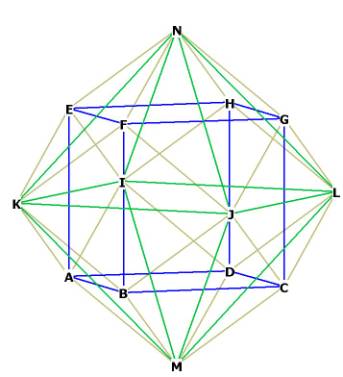|
(2017
midterm assignment) Model Student Midterm answers 2017 (Index) Essay 1: Compare, contrast, and evaluate Narratives of the Future |
 |
Greg
Bellomy
10/15/2017
Future Narratives: Comparisons and Contrasts
In telling stories about an imagined future, authors generally confine
themselves to one or a combination of two or three different types, which
include apocalypse, evolution, and alternative narratives. Because readers can
interpret texts in divergent ways, it is possible that different readers can
attribute different intentions to the author, particularly regarding their
vision of a future. An examination of the narrative types is worthwhile in
enhancing discussion of authors’ future visions.
The apocalypse narrative usually tells the story of an ending, society,
government, culture or planet. Within the Western tradition, these narratives
are primarily found within the Bible, in the books of Daniel and Revelation.
These prophecies, although made by different people at different times, share
several things in common. Most importantly, both stories involve a vague
timeline, which seem to be intended to suggest that the prophecy could be
fulfilled at any day or minute. Another thing that is inherent to both narrative
styles is the use of phantasmagorical imagery; this mode of mixing aspects of
various animals and men calls to mind the mystical nature of a surrealistic
dream state. Like the mysterious time cycles associated with this genre, this
phantasmagorical style also allows for an expanded number of ways in which the
works can be interpreted and thus connected to the life of the reader. Another
aspect that defines apocalypse narratives is their attractiveness to readers; in
a world where people sense decay and decline (rather than progress), the
apocalypse narrative offers the hope of restoration, while promising destruction
to people or institutions that would otherwise prevent them (also to many
bystanders). In this way, apocalypse narratives seem very purposed towards the
building of fear and hope, much like the religions that spawned them. While
these types of narratives remain popular today, it is much more common to see
the transplantation of apocalypse elements into other narrative forms than the
repetition of the apocalypse as a narrative template.
One
good example of the infusion of apocalypse elements into a different narrative
form is in Parable of the Sower. The book’s protagonist, Lauren Olamina,
is a daughter to a Christian preacher. The walled-in community where she lives
is slowly declining into hardship, deprivation, and violence. As Lauren’s
community members watch the world outside their walls continue to crumble, they
turn to her father for spiritual guidance and counsel until his disappearance.
Although the book is set in some sort of economic and ecological apocalypse,
Parable resists this reading at some key points. First, Lauren has a genetic
mutation that allows her to sense the pain of beings within her line of sight.
Although this development is attributed to the use or abuse of pharmaceutical
drugs, this change holds high importance within the development of the story; it
necessitates finding new ways to solve problems and places a practical limit on
the way that violence can be exercised by the character. Along with this
mutation (which readers learn that Lauren is not the only one), there is the
motif in Lauren’s journals which repeats, “God is change.” When one considers
that the entire journey is about survival and starting a sustainable community
called “Acorn,” along with the fact that most religiously inclined people have
an intention of behaving and living in a “God-like” manner, Parable is better
understood as being an evolutionary narrative.
Unlike the revealed information of the apocalypse narratives (from some divine
or mystical source), the evolutionary narrative is based upon the observation of
change over time. In Parable, Lauren’s writings about the rules and beliefs of
Earthseed are based upon her observations of what and does not work for the
purposes of survival. Likewise, the problems that Lauren and her cohorts face
seem to be based on the imagination of current problems (in Butler’s 1992) into
the future, including corporatization, drug epidemics, and environmental
disasters. HG Wells’ book The Time Machine, also builds its vision in this way.
Going hundreds of thousands of years into the future, Wells imagines the class
and social divide (partially inspired by the Industrial Revolution) forward into
the division between two biologically different species of humanoids: the gentle
Eloi are the incarnation of the upper class, and the disgusting Morlocks embody
his future vision of the proletariat. Although both
Parable and
Time Machine have their own problems
in terms of plot, the authors seem to agree about the question of what
constitutes progress. The same question is explored in “Better Be Ready Half
Past Eight,” which is set in a near-future scenario, where the protagonist deals
with his friend changing gender and sex. Once he comes to terms with this
change, the hero ends up unsure about his son’s future gender status and even
his own. Despite the uncharacteristically short timeline of this type,
Half Past Eight also illustrates the
way that changing ideas and bodies affect one another. Butler illustrates this
by showing how failing institutions and social practices dictate the development
of new mores and traits for a viable future; Wells also shows the same concept,
particularly in the evolution of the Morlocks to survive in subterranean
conditions. He also demonstrates this even more in the description of
technologies and knowledge that are gained and lost. This differs from the
tendency in apocalypse narratives of labeling things as good and evil; from the
objective viewpoint in the evolutionary narrative, these distinctions are both
impossible and unreasonable to make. The short story,” Somebody Up There Likes
Me,” also demonstrates the concept of confusion regarding quality, but more in
terms of communication. The “high signal to noise ratio” attributed to humanity
and nonsensical correspondence with a distant wife create the pervasive feeling
of anomie in the story. Because our subjective human nature generally compels us
to qualify things relative terms, a third future narrative form has been
created: the alternative narrative.
Alternative narratives of the future give authors the ability to apply their
subjective judgements to a continuum of infinite possibilities and
probabilities. In Garden of Forking Paths, the main character assassinates an
Englishman because they are enemies at one point of the branching timeline in
the future. Although this may seem abhorrent from a reader’s perspective, Borges
demonstrates the ambiguous nature of understanding an act from a perspective in
time. The same can be said of “Mozart in the Mirrorshades;” in this short story,
the denizens of one future timeline travel back into other, alternative,
timelines, to bring back oil and mineral resources. This, of course, has
disastrous effects on the worlds which they visit, but provides much needed
resources for the home world. Ironically, the denizens of the past world still
manage to distract and divide the occupiers enough so that eventually they are
forced to leave (and some time-natives manage to escape with the occupiers). In
this story, the things that were good for some in one time, are bad for another
in a different time; but, some of these same things are also the opposite for
other people. These two tales illustrate the relativistic notion within
alternative timelines, which differs from the moral and amoral perspectives of
apocalypse and evolutionary narratives. The alternative future vision, which is
not constrained by the revelation of divine wisdom or eons of unimaginable time,
gives authors the freedom to explore ideas in ways that does not quite make
temporal or spatial sense (much like quantum theory). In this sense, the
emergence of the alternative narrative seems to mirror the changing ways in
which we perceive the world.
Being
forever trapped in the present, writers will continue to provide their future
narratives, so long that writing is a part of our culture. For now, the future
of future visions is in the alternative narrative form. Apocalyptic and
evolutionary narratives will undoubtedly be borrowed from for the foreseeable
future; but, their rigidity with regards to timelines and their processes of
development will most likely limit them to being elements in an alternative
future story. Conversely, the alternative future vision allows the perfect
vehicle through which writers can suspend (or alter) the forces of God or nature
into a vision that suits their artistic intent. Likewise, the alternative
timeline represents the fringes of our comprehension, whereas the other two
styles are reliant upon what is “known,” either from God or observation.
 |
 |
 |
